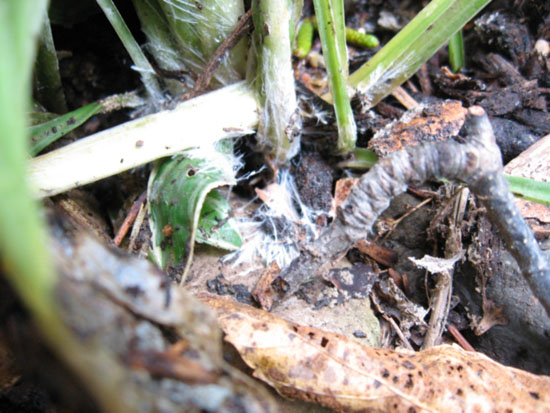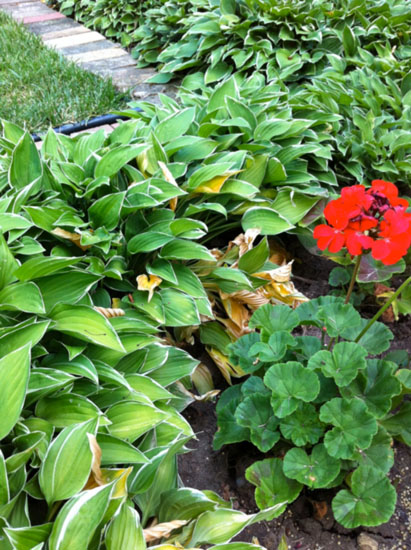Issue 9, June 18, 2012
Hosta Petiole Blight
Hostas are an essential component to every shady garden. They are available in a wide variety of sizes, leaf shapes, textures and colors. They are also very easy to propagate, transplant and share with friends and family. This unfortunately can contribute to the spread of some nasty plant diseases. Two weeks ago our newsletter included information on Hosta Virus X, a severe disease caused by a viral pathogen. This week I spotted Hosta Petiole Blight in a local landscape. This is a devastating fungal disease caused by Sclerotium rolfsii. Under favorable conditions, the pathogen can rapidly take-over and defoliate an otherwise healthy hosta. It was previously named Hosta Crown Rot, but was renamed due to the fact that the pathogen attacks the petiole while the plant's crown remains unharmed.
This pathogen is particularly devastating because of its ability to survive in the soil and on the soil surface from several months to years. Survivability is attributed to the tough, mustard seed-like overwintering structures, known as sclerotia. The pathogen becomes active during warm, humid weather at which point the sclerotia germinate and tufts of white mycelium fan out over the soil surface. When the fungus comes in contact with a host, it releases oxalic acids that break-down plant cells walls and tissues. On hostas, symptoms begin as wilting and discoloration of lower leaves. In a short time the upper leaves also wilt; and close inspection shows a soft, brown rot of the base of petioles. The entire leaf soon collapses above the site of infection.

Mustard seed-like sclerotia of Hosta Petiole Blight

Hosta Petiole Blight mycelium spreading over soil surface and hosta petioles

Early symptoms of Hosta Petiole Blight. The lower leaves are discolored, wilting and collapsing.

Blighted petiole with sclerotia
Prevention and sanitation are important for disease control. The fungus is spread by sclerotia or by mycelium growing from the sclerotia. Contaminated nursery plants and exchange between gardeners has aided long distance spread of the disease. Closely inspect plants for signs of the disease before purchasing plants or accepting plants from friends and family. If you spot the disease in your landscape, remove all of the infected plant parts, placing them directly into a bag to remove them from the garden. Be careful not to spread any of the fungal mycelium or sclerotia. Do not compost diseased plants. Remove the top several inches of soil around the plant, again being careful not to spill any as you work. Unfortunately, no effective fungicides are currently available for home owners to use. Flutolanil is available for commercial applications. As with most fungicides, they will suppress but not completely eliminate the pathogen. Mulch may contribute to the overwinter survival of the pathogen. Pulling mulch back from the base of plants before winter may help to kill the fungus. There are differences in levels of susceptibility among hosta cultivars, but nothing with high levels of resistance. Iowa State University has a very good publication on Sclerotium Blight: http://www.plantpath.iastate.edu/files/SUL8.pdf (Adobe PDF). (Travis Cleveland)
Author:
Travis Cleveland